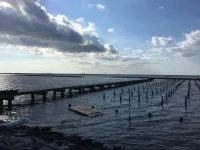(Press-News.org) The plant Aristolochia microstoma uses a unique trick: its flowers emit a fetid-musty scent that seems to mimic the smell of decomposing insects. Flies from the genus Megaselia (family Phoridae) likely get attracted to this smell while searching for insect corpses to mate over and lay their eggs in. When they enter a flower, they are imprisoned and first pollinate the female organs, before being covered with pollen by the male organs. The flower then releases them unharmed.
"Here we show that the flowers of A. microstoma emit an unusual mix of volatiles that includes alkylpyrazines, which are otherwise rarely produced by flowering plants. Our results suggest that this is the first known case of a flower that tricks pollinators by smelling like dead and rotting insects rather than vertebrate carrion," says corresponding author Prof Stefan Dötterl, the head of plant ecology group and the Botanical Gardens at the Paris-Lodron University of Salzburg, Austria. The study is published in the open access journal Frontiers in Ecology and Evolution.
Between 4-6% of flowering plants use a 'deceptive pollination strategy': they use odor, color, and touch to advertize a reward to pollinators, such as nectar, pollen, or mating and breeding sites, but don't actually give any. The deception works because pollinators are poor at distinguishing between the reward and the mimic. Deceptive pollination is typical of many orchids, but has also independently evolved in other plants, including in the genus Aristolochia (family Aristolochiaceae or birthworths).
"Aristolochia contains over 550 species around the world, especially in the tropics and subtropics. They are mostly woody vines and herbaceous perennials with striking, complex flowers that temporarily imprison their visitors to get pollinated," says Prof Christoph Neinhuis, coauthor of the study, who cultivates one of the largest Aristolochia collections worldwide at TU Dresden Botanical Garden, Germany.
When pollinators enter an Aristolochia flower, they are guided by hairs downwards to a small chamber which holds the sexual organs. Trapped inside, they deposit any pollen they carry onto the female organs, before the stamens ripen and release more pollen. When the hairs that block the entrance to the chamber wither, the pollinators can escape, and a new cycle can begin.
"Many Aristolochia species are known to attract flies with floral scents, for example mimicking the smell of carrion or feces of mammals, decaying plants, or fungi," says first author Thomas Rupp, a PhD student at the Paris-Lodron University of Salzburg. "But our curiosity was piqued by A. microstoma, a species known only from Greece: unlike other Aristolochia with their showy flowers, A. microstoma has inconspicuous brownish flowers that lie horizontally, partly buried or close to the ground among leaf litter or rocks. The flowers release an unpleasant, carrion-like smell, noticeable to people at a short distance."
Rupp and colleagues sampled A. microstoma plants from three sites in Greece: one West of Athens and two on the Peloponnese. From 1457 flowers (of which 72% were in the first, female phase) they collected a total of 248 arthropods, ranging from flies from four families to centipedes and springtails. Only female and male Megaselia flies - M. scalaris and members of the M. angusta/longicostalis cluster of closely related species, as determined through DNA barcoding and from morphology - were found carrying pollen inside its flowers, indicating that they are the normal pollinators.
The authors then used gas chromatography with mass spectrometry (GC/MS) to analyze the flowers' scent 'bouquet'. They found 16 compounds, including strong-smelling nitrogen- and sulfur-bearing volatile molecules. Among the main 'ingredients' were oligosulfides, produced by many plant species whose pollinators are carrion flies or bats: a fetid scent characteristic of decomposing meat. But surprisingly, another was 2,5-dimethylpyrazine (8-47% of total composition), a musty scent typical of cooked rice or roasted peanuts - known in nature to occur in the carapace of decomposing beetles and well as in the urine of rodents. Very few plants are known to produce this compound, strongly suggesting that A. microstoma mimics an unusual fake 'reward' to attract specialist pollinators.
"Earlier studies had suggested that A. microstoma might be pollinated by leaf litter-dwelling insects such as ants, because of the orientation and position of the flowers. But here we show that this isn't correct: instead, the main pollinators are Megaselia 'coffin flies'. As their name suggests, these flies feed on carrion, on which they lay their eggs and which serves as food for the larvae, which is why they are often used as evidence in forensic medicine," says Dötterl.
"We show A. microstoma flowers emit a simple but highly unusual mix of scents that includes 2,5-dimethylpyrazine, a molecule that occurs neither in vertebrate carcasses nor in feces, but does occur in dead beetles. We conclude that A. microstoma likely uses a strategy that has never been reported before: its flowers mimic the smell of invertebrate carrion to attract and imprison pollinators. The peculiar orientation of the flowers close to the ground may also help, as pollinating coffin flies search for breeding sites or food close to the ground, in leaf litter or between rocks," concludes coauthor Prof Stefan Wanke from TU Dresden, Germany.
INFORMATION:
UK doctors have nothing to fear from the introduction of a central register listing money or benefits they receive in addition to their NHS salary, say experts today ahead of a public meeting on the issue hosted by the All-Party Parliamentary Group for First Do No Harm and The BMJ.
Last year the Independent Medicines and Medical Devices Safety Review, chaired by Baroness Julia Cumberlege, investigated harmful side effects caused by the hormone pregnancy test Primodos, the anti-epileptic drug sodium valproate, and pelvic mesh.
During the review, she heard from patients who were concerned that clinicians ...
Within the next decade, the novel coronavirus responsible for COVID-19 could become little more than a nuisance, causing no more than common cold-like coughs and sniffles. That possible future is predicted by mathematical models that incorporate lessons learned from the current pandemic on how our body's immunity changes over time. Scientists at the University of Utah carried out the research, now published in the journal Viruses.
"This shows a possible future that has not yet been fully addressed," says Fred Adler, PhD, professor of mathematics and ...
LA JOLLA, CA--Fast-spreading variants of the COVID-19-causing coronavirus, SARS-CoV-2, carry mutations that enable the virus to escape some of the immune response created naturally or by vaccination. A new study from scientists at Scripps Research, along with collaborators in Germany and the Netherlands, has revealed key details of how these escape mutations work.
The scientists, whose study appears in Science, used structural biology techniques to map at high resolution how important classes of neutralizing antibodies bind to the original pandemic ...
Environmental quality is associated with advanced-stage prostate cancer at diagnosis, according to a new study by University of Illinois Chicago researchers.
Prostate cancer is up to 57% heritable, with the remainder attributed to environmental exposures. However, studies on those environmental factors and prostate cancer aggressiveness have previously been limited. For their study, "Association between environmental quality and prostate cancer at diagnosis," published in the journal Prostate Cancer and Prostatic Disease, researchers paired data from the environmental quality index, or EQI, and the Surveillance, ...
Around the world and within the U.S., the percentage of people wearing masks during the Covid-19 pandemic has varied enormously. What explains this? A new study co-authored by an MIT faculty member finds that a public sense of "collectivism" clearly predicts mask usage, adding a cultural and psychological perspective to the issue.
The study uses a series of datasets about mask usage and public attitudes, along with well-established empirical indices of collectivism, to evaluate the impact of those cultural differences on this element of the pandemic response. ...
Flies predict changes in their visual environment in order to execute evasive maneuvers, according to new research from the University of Chicago. This reliance on predictive information to guide behavior suggests that prediction may be a general feature of animal nervous systems in supporting quick behavioral changes. The study was published on May 20 in PLOS Computational Biology.
Animals use their sensory nervous systems to take in information about their environments and then carry out certain behaviors in response to what they detect. However, the nervous system takes time ...
The immune system is a complex balancing act; if it overreacts or underreacts to foreign molecules, there can be serious health consequences.
For cancer patients, tumor progression is often accompanied by immunosuppression, meaning their bodies can't fight off pathogens the way they should. By contrast, for people with autoimmune diseases like type 1 diabetes, rheumatoid arthritis, and multiple sclerosis, their immune systems overreact and attack the body itself.
Both of these reactions are influenced by a series of molecular checkpoints found in both immune cells and cancer cells. In immune ...
Oysters live and grow in saltwater. However, the saltiness of their habitat can change dramatically, especially where the mighty Mississippi River flows into the Gulf of Mexico. Louisiana oysters from the northern Gulf of Mexico may experience some of the lowest salinity in the world due to the influx of fresh water from the Mississippi River. In addition, increased rainfall and large-scale river diversions for coastal protection will bring more fresh water that does not bode well for the eastern oyster. New research led by Louisiana State University (LSU) alumna Joanna Griffiths from Portland, Oregon, and her faculty advisor ...
ROCHESTER, Minn. -- You might be older - or younger - than you think. A new study found that differences between a person's age in years and his or her biological age, as predicted by an artificial intelligence (AI)-enabled EKG, can provide measurable insights into health and longevity.
The AI model accurately predicted the age of most subjects, with a mean age gap of 0.88 years between EKG age and actual age. However, a number of subjects had a gap that was much larger, either seemingly much older or much younger by EKG age.
The likelihood to die during follow-up was much ...
During the pandemic, the old waiting room phrase "the doctor will see you now" has taken on a new meaning. So has the waiting room. Our kitchen table or living room couch is where many people do work lately, and that includes visits to the doctor. New research from Syracuse University's Falk College indicates this method of health care will continue even after COVID numbers are (hopefully) reduced.
"I was surprised by the results," said the study's lead author Bhavneet Walia, assistant professor of public health at Syracuse University. "I initially thought that, because of the challenges of telehealth, physicians would not be in favor of continuing post-pandemic. It turns out they do. But ...




